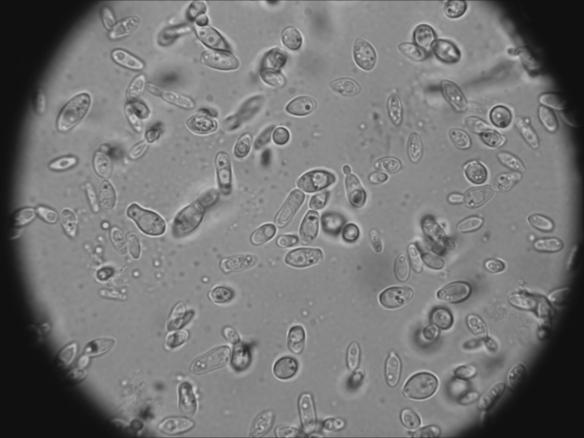Eureka, its time for yet another post about Brettanomyces. And today, we are looking at some Brettanomyces lambicus cells. You might remember, that I did some plating of the two Brettanomyces strains from Wyeast: Brettanomyces bruxellensis and Brettanomyces lambicus on Sabouraud agar. And I already posted the results from the microscopy observation of a B. bruxellensis sample. Now is the time to talk about the microscopy observation of the B. lambicus cells from Wyeast.
Lets begin with a few pictures now to get an overview. I will get into further details in the pictures below.
My first impression is that B. lambicus, much like B. bruxellensis, appears in very different shapes. There are boat-shaped cells, elongated cells, and even cells that attach to each other. But very few of the cells are circular like normal brewers yeast. Maybe the circular cells here might be brewers yeast impurities in the Brettanomyces sample. To summarize, B. lambicus seems to look quite different from brewers yeast (Saccharomyces cerevisiae). Lets go into more details at a higher magnification.
The cells seem to have a kind of vacuole (Fig 4). The vacuole can be observed as a kind of compartment in the cell itself. It is much easier to observe in the next picture (Fig 5).
Interestingly, there is something circular in the vacuole. I will come back to this observation later on.
It can be observed now, that the cells have again, like B. bruxellensis, one or two dark spots (Fig 6). I am still figuring out what these dark spots might be. But now back to the most interesting observation from my point of view. I already mentioned, that I could observe some kind of circular structure in the cells vacuole (see Fig 5). One disadvantage of pictures is their snapshot nature. The pictures just represent a short state of a cell. Just have a look the following video I took to see what the cells really looked like for real. Observe what happens inside the vacuole. I have to apologize for the bad quality of the video.
Have you noticed that the circular structure moved in the cells vacuole? Well, I have never observed something like that before. In my opinion there are several possible explanations for such a movement.
– One would be that there is a kind of dynamic movement in the vacuole itself. Much like mixing the vacuoles content in some way. And the circular structure then could be maybe a vesicle with some sort of nutrients in it and swirl around due to the dynamic movement in the vacuole.
– Another explanation, there is a kind of other cell in there. But this seems to be very unlikely to me. I have several reasons to come to such a conclusion. One would be how these cells would have gotten there in the first place.
– Sporulation. Could these structures be spores?
This is very exciting in my opinion. A lot of questions. I have several further investigations in mind to get further information about that circular structure in there. If someone out there has any idea what these structures could be, please comment below. Please comment as well if you have observed such a movement yourself.
What have I learned from the microscopy observations so far?
The observations helped me to understand the different morphologies of the Brettanomyces yeast cells. This can be observed if you look at different microscopy pictures as well. But looking at them yourself is very different. And this helped me to identify several yeasts I harvested from different sources to be Brettanomyces. On the other hand, colonies on the agar plates of the two strains looked very similar and I could not distinct between them. I addition, the colonies of Saccharomyces cerevisiae looked very similar to the ones from the Brettanomyces as well. I could not even distinct between Saccharomyces and Brettanomyces by just looking at the colonies on the Sabouraud agar. Only a microscopy observation can help to make such a distinction. It is therefore inevitable to look at the cells to get an idea what kind of yeast you have.
That’s all so far about the two Brettanomyces strains from Wyeast. Unfortunately, I can’t get my hands on the White Labs strains here. So no further pure strain observations will follow. What I have planned is to write some posts about Brettanomyces in general. And the first post about “Brettology” will be a post about the taxonomy of Brettanomyces. So stay tuned and thank you for your comments!















